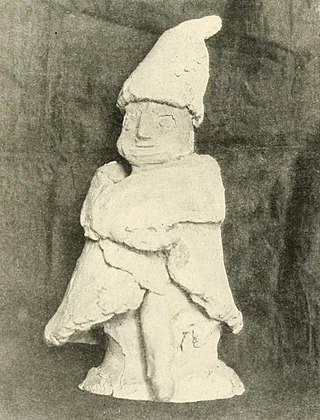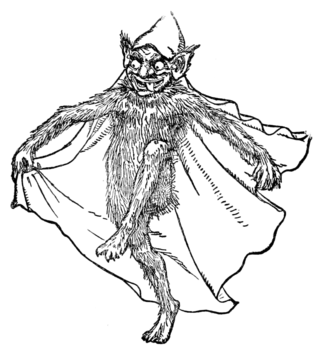
A fairy is a type of mythical being or legendary creature, generally described as anthropomorphic, found in the folklore of multiple European cultures, a form of spirit, often with metaphysical, supernatural, or preternatural qualities.

Menehune are a mythological race of dwarf people in Hawaiian tradition who are said to live in the deep forests and hidden valleys of the Hawaiian Islands, hidden and far away from human settlements.

A leprechaun is a diminutive supernatural being in Irish folklore, classed by some as a type of solitary fairy. They are usually depicted as little bearded men, wearing a coat and hat, who partake in mischief. In later times, they have been depicted as shoe-makers who have a hidden pot of gold at the end of the rainbow.
In Finnish mythology and lore, a menninkäinen is believed to be a leprechaun-like inhabitant of the forests. Fairy tale depictions often involve riddling, dominance struggles and favors elicited. Menninkäinen were probably originally thought to be spirits of dead people, but folklore about them has changed during time, and they turned to be something else.
A hobgoblin is a household spirit, appearing in English folklore, once considered helpful, but which since the spread of Christianity has often been considered mischievous. Shakespeare identifies the character of Puck in his A Midsummer Night's Dream as a hobgoblin.

A pixie is a mythical creature of British folklore. Pixies are speculated to be particularly concentrated in the high moorland areas around Devon and Cornwall, suggesting some Celtic origin for the belief and name. However, the word 'pixie' also appears in Dorset, Somerset and to a lesser extent in Sussex, Wiltshire and Hampshire.

The púca, pucapwca, pooka, phouka, puck is a creature of Celtic, English, and Channel Islands folklore. Considered to be bringers both of good and bad fortune, they could help or hinder rural and marine communities. Púcaí can have dark or white fur or hair. The creatures were said to be shape-changers that could take the appearance of horses, goats, cats, dogs, and hares. They may also take a human form, which includes various animal features, such as ears or a tail.
Fairies, particularly those of Irish, English, Scottish and Welsh folklore, have been classified in a variety of ways. Classifications – which most often come from scholarly analysis, and may not always accurately reflect local traditions – typically focus on behavior or physical characteristics.

An imp is a European mythological being similar to a fairy or demon, frequently described in folklore and superstition. The word may perhaps derive from the term ympe, used to denote a young grafted tree.

Little people have been part of the folklore of many cultures in human history, including Ireland, Greece, the Philippines, the Hawaiian Islands, New Zealand, Flores Island, Indonesia, and Native Americans.

In Breton folklore, a Korrigan is a fairy or dwarf-like spirit. The word korrigan means in Breton "small-dwarf". It is closely related to the Cornish word korrik which means gnome. The name changes according to the place. Among the other names, there are korrig, korred, korrs, kores, couril, crion, goric, kornandon, ozigan, nozigan, teuz, torrigan, viltañs, poulpikan, poulpiquet, and paotred ar sabad.

A household deity is a deity or spirit that protects the home, looking after the entire household or certain key members. It has been a common belief in paganism as well as in folklore across many parts of the world.

A lutin is a type of hobgoblin in French folklore and fairy tales. Female lutins are called lutines.
Mythic humanoids are legendary, folkloric, or mythological creatures that are part human, or that resemble humans through appearance or character. Each culture has different mythical creatures that come from many different origins, and many of these creatures are humanoids. They are often able to talk and in many stories they guide the hero on their journey.
A Pukwudgie, also spelled Puk-Wudjie, is a human-like creature of Wampanoag folklore, found in Delaware, Prince Edward Island, and parts of Indiana and Massachusetts, sometimes said to be two to three feet tall.

A brownie or broonie (Scots), also known as a brùnaidh or gruagach, is a household spirit or Hobgoblin from Scottish folklore that is said to come out at night while the owners of the house are asleep and perform various chores and farming tasks. The human owners of the house must leave a bowl of milk or cream or some other offering for the brownie, usually by the hearth. Brownies are described as easily offended and will leave their homes forever if they feel they have been insulted or in any way taken advantage of. Brownies are characteristically mischievous and are often said to punish or pull pranks on lazy servants. If angered, they are sometimes said to turn malicious, like boggarts.

A goblin is a small, grotesque, monstrous creature that appears in the folklore of multiple European cultures. First attested in stories from the Middle Ages, they are ascribed conflicting abilities, temperaments, and appearances depending on the story and country of origin, ranging from mischievous household spirits to malicious, bestial thieves. They often have magical abilities similar to a fairy or demon, such as the ability to shapeshift.
Gwragedd Annwn, alternatively known as Dames of the Lower Region, Dames of Elfin Land, or Wives of the Lower World, are beautiful female fairies who live beneath lakes and rivers found in Welsh folklore. They are counted among the Tylwyth Teg or Welsh fairy folk.The mythological narrative of Gwragedd Annwn is intertwined with the origin of the Welsh black cattle. Some legends hold that the existence of the Gwragedd Annwn was owed to the famed Saint Patrick. Occasionally, the fairies were said to ascend into the upper world, and be visible to ordinary people.
A Bieresel is a type of kobold of German folklore.
Sleih beggey is the umbrella term for Manx fairies.











